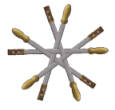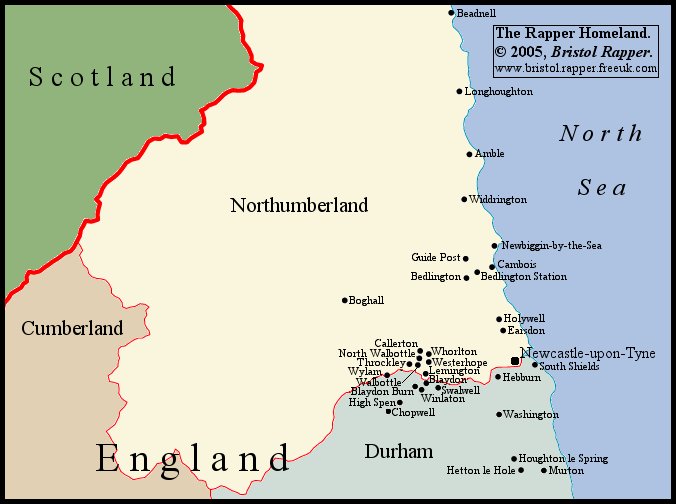 |
 |
 |
|
||
 |
 |
 |
|
||
What do we do?
| There are two forms of traditional
sword-dance originating from the North of England; the Longsword
dance, from Yorkshire, and the Shortsword,
or Rapper-Sword dance, from the former
counties of Northumberland and Durham. We perform the
latter. Whereas the longsword dance is performed by six or eight men (depending on the tradition) and uses rigid swords, the Rapper-Sword dance is for five men and uses double-handled flexible swords called Rappers. The origin of this word is uncertain, though some say that rapper is a corruption of rapier. The blade of the rapper is made of spring steel. One end of a rapper is terminated with a fixed handle, called the Butt; at other end is a swivelling handle, called (naturally) the Swivel. |
Butt. |
Swivel. |
| Ritual dancing
using swords existed throughout Europe and goes back many
centuries, but the unique form of it called Rapper
- using flexible swords - was developed by miners from
the coal-mining villages of Northumberland and Durham
during the early nineteenth century. How they had the
energy for it after a day down the pit and a meagre diet
of brown ale, stottie cake and leek pudding is something
of a mystery! Some theories suggest that the miners
adapted tools to make rappers, or that rappers were used
to scrape down the backs of pit ponies, but there is no
hard evidence for this. Although rapper is a relatively
late origin, the flexibility of the rappers allows for
much greater intricacy, speed and excitement than is the
case with the earlier sword dances. Each village had its
own variant of the dance, and these variants today are
referred to as traditions - each
tradition taking the name of the village from whence it
came. To a casual observer, the dance has an appearance of symmetry, and it might be supposed that each dancer has an identical role. However, this is not the case: each dancer has a number (from 1 to 5) with a different requirement of when to turn and move. A good dancer might be capable of dancing at more than one position, should the need arise. To find a dancer that could dance well in any of the five positions then, as now, would be a rarity. Traditionally (and now) dancers are attired in a uniform manner, this "uniform" now being referred to as the Kit. Each side (then, as now) has different kit, to distinguish itself from all other rapper sides. Rapper is normally danced in breeches, rarely in trousers. In the north, Hoggers (similar to breeches, but loose-fitting at the knee) are more commonly worn, and are probably more authentic. Footwear may be clogs or shoes. Other options are waistcoats or sashes (cummerbunds). As with any form of co-ordinated dancing there has to be a leader, and in rapper this leader is called the Captain. This may originate from mining parlance (a man in charge of a pit being called a mine captain) rather than with a military captain as might be thought - given the association with swords. The music for the dance is provided by a solo Musician, usually playing a fiddle, concertina, or melodeon. There is no particular tune associated with the dance: any fast 32-bar jig (6/8 time) will serve, though some are better than others. Most musicians will play a medley of jigs to cover the duration of the dance; examples of traditional choices (still used today) are: the Blackthorn Stick, the Tenpenny Bit, the Irish Washerwoman, Irish Whiskey, Father O'Flynn, Paddy the Dandy and the Old Horned Sheep. In addition to the five dancers, the captain and the musician, some traditions also had a man dressed in woman's clothes called the Bessy, the Betty or Dirty Bet who collected money from bystanders. Some traditions also had a fool character, called the Tommy, or Tom Fool. The group of performers as a whole is referred to as a Rapper Team or a Rapper Side. In Bristol Rapper, there are (at least, currently) some departures from tradition; no acting is incorporated, the captain is also the No. 1 dancer, and there is no Bessy or Tommy. Throughout the most of the dance, the dancers Step in time with the music. The cycle (continuously repeating) is :
Each impact with the floor equates to a quaver in the music; thus a stepping cycle equals one bar, there being six impacts matched to the six quaver beats to the bar of the accompanying jig. Some parts of the dance require marching, rather than stepping. For these parts, one pace equates to three quavers, or half a bar. In many traditions, the dance is preceded by a Calling on Song, rendered by the captain. Between the song and the dance proper, some traditions also have a section of acting (rather like short Mummers play). This features a feigned quarrel, in which one of the actors is "wounded". A "ten pound doctor" is then summoned, who then restores the actor to normality and the dance itself begins. All rapper-sword dances are divided into sections, called Figures. Each figure has a name - sometimes descriptive, e.g. Breast-Plate, and other times somewhat esoteric, e.g. Glass Haymarket. Figures can be roughly classified into generic types: circle, line, figure-of-eight and coach-and-horses. Some figures involve jumping over the swords. Others require a dancer (or dancers) to make a backward somersault(s) over the swords - the Tumble. Some traditions incorporate a Chorus Figure; i.e. a set figure that is danced at the end of each figure. To aid co-ordination, near the end of each figure, the captain calls the name of the next figure to be danced (usually, in a stentorian voice!). At various points in the dance the swords are interwoven into an inverted basket shape called the Nut or the Rose, and then held up and displayed from an inwardly-facing circle formation. At the end of dance (and at intermediate points) the rappers are tied into the Lock, which is displayed held-high by the captain (or sometimes by one of the other dancers, as dictated by the interests of symmetry). The following is an (albeit, incomplete) attempt at a classification of places having rapper teams in the late 1800s or early 1900s - any information on errors or omissions will be gratefully received and incorporated. Not all of these can be regarded as distinct traditions though; for example, North Walbottle (started 1906) was a re-introduction of the Bedlington dance, which had already ceased at its place of origin. The C# column refers to the Sword Dances of Northern England, by Cecil J. Sharp, Parts I-III (reprinted as ISBN 0 7158 1211 4). |
Village or Place |
Former County |
Modern County or Unitary Auth. |
Time Performed |
Musician(s) |
Others |
C# |
Amble |
Northumberland |
Northumberland |
? |
? |
? |
- |
Beadnell |
Northumberland |
Northumberland |
New Year's Day |
? |
Two Bessies |
II |
Bedlington |
Northumberland |
Northumberland |
? |
Piano |
? |
- |
Bedlington Station |
Northumberland |
Northumberland |
? |
? |
? |
- |
Blaydon |
Durham |
Gateshead |
? |
? |
? |
- |
Blaydon Burn |
Durham |
Gateshead |
? |
? |
? |
- |
Boghall |
Northumberland |
Northumberland |
? |
? |
? |
- |
Callerton |
Northumberland |
Newcastle-u-Tyne |
? |
? |
? |
- |
Cambois |
Northumberland |
Northumberland |
? |
? |
? |
- |
Chopwell |
Durham |
Gateshead |
? |
? |
? |
- |
Earsdon |
Northumberland |
North Tyneside |
Christmas Eve |
Fiddle |
Captain, Bessy |
I |
Guide Post |
Northumberland |
Northumberland |
? |
Highland Bagpipes |
? |
- |
Hebburn |
Durham |
South Tyneside |
? |
? |
? |
- |
Hetton-le-Hole |
Durham |
Sunderland |
? |
? |
? |
- |
High Spen |
Durham |
Gateshead |
? |
Melodeon |
? |
- |
Holywell |
Northumberland |
North Tyneside |
? |
? |
? |
- |
Houghton-le-Spring |
Durham |
Sunderland |
? |
? |
? |
- |
Lemington |
Northumberland |
Newcastle-u-Tyne |
? |
? |
? |
- |
Longhoughton |
Northumberland |
Northumberland |
? |
? |
? |
- |
Murton |
Durham |
Durham |
? |
? |
? |
- |
North Walbottle |
Northumberland |
Newcastle-u-Tyne |
? |
Concertina |
Bessy, Tommy |
III |
Newbiggin-by-the-Sea |
Northumberland |
Northumberland |
? |
Melodeon |
? |
- |
South Shields |
Durham |
South Tyneside |
? |
? |
? |
- |
Swalwell |
Durham |
Gateshead |
Christmas Eve >= |
Fiddle, Melodeon |
Captain, Betty |
I |
Throckley |
Northumberland |
Newcastle-u-Tyne |
? |
? |
? |
- |
Walbottle |
Northumberland |
Newcastle-u-Tyne |
? |
? |
? |
- |
Washington |
Durham |
Sunderland |
? |
Northumbrian Smallpipes |
? |
- |
Westerhope |
Northumberland |
Newcastle-u-Tyne |
? |
? |
? |
- |
Whorlton |
Northumberland |
Northumberland |
? |
? |
? |
- |
Widdrington |
Northumberland |
Northumberland |
? |
? |
? |
- |
Winlaton |
Durham |
Gateshead |
? |
Tin whistle |
Betty |
III |
Wylam |
Northumberland |
Newcastle-u-Tyne |
? |
? |
? |
- |
| The map below, The Rapper
Homeland, shows the locations of the
traditional rapper teams in their original English
counties. If you wish to reproduce this map on your own rapper-related website, you may do without infringement of copyright, providing that you comply with the following conditions:
|
 |
| Bristol Rapper
performs dances based on three of the above traditions (High
Spen, Newbiggin-by-the-Sea and Winlaton),
and uses the calling-on song from Earsdon. It remains to explain how a custom originally confined to a few dozen villages in the North-East spread to the rest of the UK, and elsewhere. In the early 1900s, increasing industrialisation was causing a mass movement of the working population away from the villages, and into the cities. Some people were concerned, and rightly so, that traditions and customs might be lost forever as a result. The most notable of these was Cecil J. Sharp, who spent much of his time travelling the country by train and bicycle, observing, then documenting folk-dance and music for posterity. His collection: the Sword Dances of Northern England (published in three parts) became of just one of the works of reference used the many folk clubs and societies that were subsequently formed, thus facilitating the revival of this custom not only in its area of origin, but to other parts of the UK. It has also since spread to other parts of the world, including the USA, Canada and New Zealand. In the UK, rapper is still stronger in its heartland of the North-East, than elsewhere. For more information on rapper sword dancing, and other traditional folk activities, please visit the links below: |
Web Site |
Link |
Description |
| Rapper Online | UK National Rapper Web Site. | |
| The Morris Ring | UK Assocation of Men's Morris & Sword Dance Clubs. | |
| Folking.com | Folk Community Web Site. |
![]()